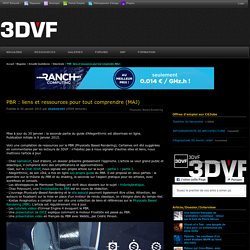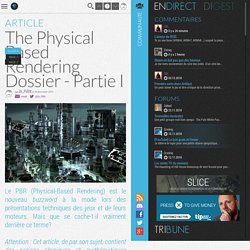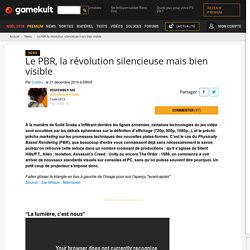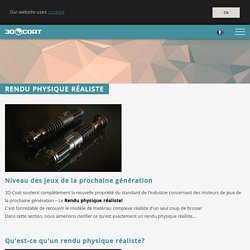

ZWrap. Galleries – Surface Mimic: 3D scans for digital artists. Micro Fabrics in Substance Painter by Jonas Skoog – Texturing.xyz. In this tutorial I will go through my workflow for using micro fabric maps in Substance Painter. After seeing Michael Cauchis tutorial on using these maps in Maya I wanted to try out how that could apply in Substance Painter.I wanted the process to be easy to set up by using all maps directly without combining anything before hand. For this to work I had to find a way to use the ID map as base color much like the setup in Maya.The trick would be to isolate each channel and remap its color to my liking.Unfortunately I was not able to find an easy way to do this inside Painter in the way I wanted so I decided to create a simple filter inside of Substance Designer instead to fill my needs. Substance Designer viewport To create a filter the easiest way is to just choose a “Painter Filter” template when starting a new substance graph.
This will give you two nodes, one input and one output. Setting up a basic material from the three maps is very straight forward: PBR : liens et ressources pour tout comprendre (MAJ) Mise à jour du 30 janvier : la seconde partie du guide d'Allegorithmic est désormais en ligne.Publication initiale le 9 janvier 2015.

Voici une compilation de ressources sur le PBR (Physically Based Rendering). Certaines ont été suggérées en commentaires par les lecteurs de 3DVF : n'hésitez pas à nous signaler d'autres sites et liens, nous mettrons l'article à jour. - Chez Gamekult, tout d'abord, un dossier présente globalement l'approche. L'article se veut grand public et didactique, il comprend donc des simplifications et approximations. -Gael, sur le Chat 3DVF, nous signale son propre article sur le sujet : partie 1 - partie 2. - Allegorithmic, de son côté, a mis en ligne son propre guide du PBR.
Le PBR (Physically Based Rendering) avec WebGL - Cédric Pinson. Readings on Physically Based Rendering – Interplay of Light. Over the past two years I’ve done quite a bit of reading on Physically Based Rendering (PBR) and I have collected a lot of references and links which I’ve always had in the back of my mind to share through this blog but never got around doing it.

Christmas holidays is probably the best chance I’ll have so I might as well do it now. The list is by no means exhaustive, if you think that I have missed any important references please add them with a comment and I will update it. Linear Lighting and Shading There is probably no point in talking about PBR, without first understanding why we should do all lighting and shading in linear space. This is why: The Importance of being Linear. Physically-Based Rendering, And You Can Too! By Joe “EarthQuake” Wilson This tutorial will cover the basics of art content creation, some of the reasoning behind various PBR standards (without getting too technical), and squash some common misconceptions. Jeff Russell wrote an excellent tutorial on the Theory of Physically Based Rendering, which I highly recommend reading first. Additional help from Jeff Russell, Teddy Bergsman, and Ryan Hawkins.
Special thanks to Wojciech Klimas and Joeri Vromman for the extra insight and awesome art. Contents A New Standard Fast becoming a standard in the games industry due to increased computing power and the universal need for art content standardization, physically based rendering aims to redefine how we create and render art. Physically-Based Rendering, And You Can Too! PBR Guide. The Physical Based Rendering Dossier - Partie II - Article Technique, Physical Based Rendering PBR - Article. The Physical Based Rendering Dossier - Partie I - Article Technique, Physical Based Rendering PBR - Article. (10h13)Crusing Revenons au jeu video, ghost recon widlands 2 : [facebook.com] (09h50) Crusing (9h49) CQFD.

PBR : liens et ressources pour tout comprendre (MAJ) Le PBR, la révolution silencieuse mais bien visible. Faites glisser le triangle en bas à gauche de l'image pour voir l'aperçu "avant-après"Source : Joe Wilson - Marmoset “La lumière, c’est nous” Pour bien saisir ce que le Physically Based Rendering apporte à vos jeux, il est nécessaire de comprendre le rôle de la gestion des lumières, ainsi que leur fonctionnement jusqu’à présent.

Par les éclairages, les artistes véhiculent toute une série d’informations capitales : formes, couleurs, ambiances, unités de temps... Ainsi, les couleurs chaudes sur l’horizon suggèrent par exemple un soleil couchant, tandis qu’une lumière froide baigne plutôt les scènes nocturnes. Pas besoin de vous faire un dessin.
Rendu physique réaliste – 3DCoat. Les isolateurs sont des matériaux qui ont une forte dispersion et l’effet miroir faiblement prononcé (plastique, tissu, bois, béton, peinture, etc.).

Nous pouvons voir que le plastique rouge est rouge grâce à la diffusion. Et la réflexion nous donne la possibilité de voir des éclats sur la surface. Les métaux (acier, fer, or, cuivre, bronze, argent, etc.) sont les matériaux n’ayant pas la dispersion (leur diffusion est toujours noire), mais ayant le reflet de couleur prononcée.